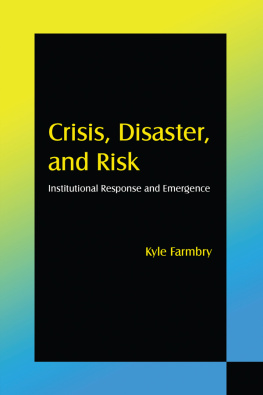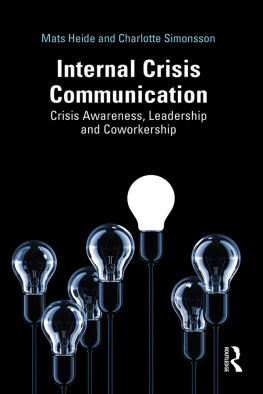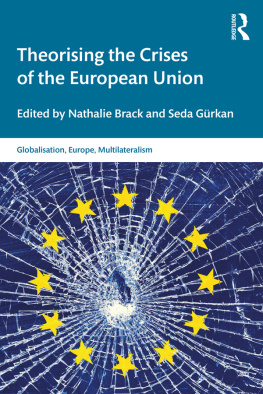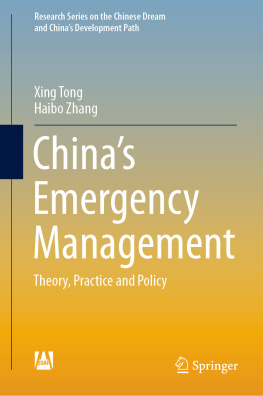First published 2013 by M.E. Sharpe
Published 2015 by Routledge
2 Park Square, Milton Park, Abingdon, Oxon OX14 4RN
711 Third Avenue, New York, NY 10017, USA
Routledge is an imprint of the Taylor & Francis Group, an informa business
Copyright 2013 Taylor & Francis. All rights reserved.
No part of this book may be reprinted or reproduced or utilised in any form or by any electronic, mechanical, or other means, now known or hereafter invented, including photocopying and recording, or in any information storage or retrieval system, without permission in writing from the publishers.
Notices
No responsibility is assumed by the publisher for any injury and/or damage to persons or property as a matter of products liability, negligence or otherwise, or from any use of operation of any methods, products, instructions or ideas contained in the material herein.
Practitioners and researchers must always rely on their own experience and knowledge in evaluating and using any information, methods, compounds, or experiments described herein. In using such information or methods they should be mindful of their own safety and the safety of others, including parties for whom they have a professional responsibility.
Product or corporate names may be trademarks or registered trademarks, and are used only for identification and explanation without intent to infringe.
Library of Congress Cataloging-in-Publication Data
Farmbry, Kyle, 1970
Crisis, disaster, and risk: institutional response and emergence / by Kyle Farmbry.
p. cm.
Includes bibliographical references and index.
ISBN 978-0-7656-2419-2 (hbk. : alk. paper)ISBN 978-0-7656-2421-5 (pbk. : alk. paper)
1. Emergency management. 2. Disaster relief. 3. RiskSociological aspects. I. Title.
HV551.2.F37 2012
658.477dc23 2012000156
ISBN 13: 9780765624215 (pbk)
ISBN 13: 9780765624192 (hbk)
_______________________
No problem can be solved from the same consciousness that created it.
Albert Einstein
W e tend not to think about crises muchthat is, until they happen. It is often then that we begin to ask ourselves a myriad of questions with the intention of further understanding the complex dynamics of the situation at hand. Why did this happen? What specific incidents are related to this? How did the various sequences of events develop? What are the roles of various responded? How are the survivors managing? What can weindividually, locally, regionally, nationally, or even internationallydo either to prevent this from happening again or to minimize the impact of such an event in the future?
I found myself asking questions similar to these in 2004. A few days after Christmas, I sat glued to the television set in my central Istanbul hotel. I was only a few hours off a plane from Beirut, where I had spent the previous week celebrating the marriage of one of my friends from college, Kamal. He and his new wife, Marianne, were now off celebrating their honeymoon on various beaches in Malaysia and Thailand. At my hotel bar, however, I found myself fearing the worst for them: Phuket, one of Kamal and Mariannes destinations, was suddenly all over the news as one of the sites where a tsunami of unprecedented magnitude had hit the shores on the morning of December 26, a few days before my having access to news of the events. Now recognized as one of the worst natural disasters of recent history, the tsunami resulted in over 250,000 deaths in the fourteen countries impacted. Thousands of others were left with major injuries, and still others were displaced for months, if not years, thereafter.
The next few days consisted of a flurry of e-mails and calls to other wedding guests. Had we heard from Kamal and Marianne? Did anyone know if they were okay? With each image of the impacted areas, and each interview with eyewitnesses and survivors, we found our dread rising as we feared the worst for our friends.
About a week after the tsunami hit Phuket, the e-mail arrived: We are okay, Kamal wrote. The two of them had been on higher ground the morning of the tsunamiand were safe. While many of us breathed a sigh of relief at this news, thousands of others were not so fortunate. The days and weeks that followed brought numerous stories of communities that were affected by the crisis and many more stories of lives lost.
The tragedy of the Asian tsunami started what was to be a year of tremendous crises all over the world. The tsunami was followed a few months later by summer floods throughout Europe, Hurricane Katrina in September, and an earthquake in Kashmir in October. Ultimately, the combined tragedies within that twelvemonth cycle led the World Health Organization to ask if 2005 was a year of natural disasters (Braine 2006, 4).
For me, the tsunami began a several-year journey of thinking about emergencies and crises. How do we conceptualize them? How do we absorb the individual stories of human tragedy with the magnitude of the statistics that frequently accompany wide-scale crisis? What types of responses can we develop? What are the roles of various societal institutional actors in responding to them? From the perspective of an academicwhat theoretical and methodological frameworks are behind our conceptualization and response to crises? From the nonacademic and nonanalytical perspective of simply existing as another being in the same world, where tragedy begets losswhat are the proper means for demonstrating a sense of caring and concern?
I tend to look at 2005 not so much as a year of disasters, but rather as a year in which there was a shift in how we thought about disasters, at least in the short term. Questions of place and proximity, community resilience, and the human spirit all surfaced in much of the discourse related to disaster during this period. The images of children who lost parents in the tsunami led us to give of our personal and financial resources in unprecedented amounts globally, and the stories of people who lost their homes as a result of Hurricane Katrina encouraged many of us to open our communities to them.
Crisis, Disaster, and Risk: Institutional Response and Emergence is the result of my reflection and sense-making on crises between 2005 and 2011. The book emerges from the recognition that an increasing number of emergencies, of varying forms and magnitudes, have surfaced in recent years and my contention that agencies need to adapt their patterns of response based on lessons learned from each new crisis. It also stems from my belief that we need to start thinking about crises and disasters not only from a framework of incident reporting, but also from a framework that encourages reflection on connectivity and complexity. By adopting a framework that attempts to incorporate questions of theory and historical connectivity, I both hope and anticipate that we will identify ways to reduce the tolls of the next disaster.
Oddly, the final months of my completion of this book coincided with the emergence of several disasters, which forced me to think further about how we conceptualize such events. In January 2010, as I was finishing the first draft of a chapter on earthquakes, Haiti and then Chile were struck by major earthquakes. In April, the Eyjafjallajkull volcano in Iceland erupted, disrupting air travel around the world. The explosion of the








